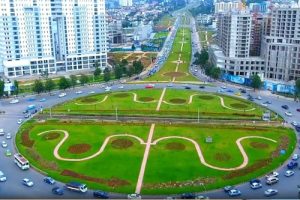
Today marks a new era for Ethiopia due to several factors, with the success of the Green Legacy Initiative (GLI) being crucial for Africa and the world to breathe cleaner air. Ethiopia’s effort involves planting trees to restore forest coverage and combating the threat of climate change.
Climate change impacts are a significant threat to the world, largely attributed to activities such as burning fossil fuels, manufacturing, deforestation, transportation, food production, and building operations. Deforestation poses a severe threat to the survival of the life system, making Ethiopia’s efforts particularly vital.
Even though Ethiopians are naturally fortunate to have comfortable weather, it has become more advanced and moderated since the initiation of the Green Legacy program. As it is widely known, different records have been registered that can be noted as an example at the continental and even international level. The initiative has not been limited to Ethiopia alone; it has also expanded to East African countries like Djibouti, Kenya, Uganda, and others. Ethiopia is blessed with comfortable weather, which is observed by foreigners who often travel to our land when they experience difficulty with the weather in their hometowns.
Our institution, the Ethiopian Institute of Agricultural Research (EIAR), is actively leading the charge in the national campaign for tree planting through the Green Legacy initiative. We are dedicated to advancing agricultural development by creating, adapting, and promoting technology through our extensive agricultural research programs. Among our many research areas, we are specifically focused on sustainable water and soil management to effectively preserve natural resources and contribute significantly to the GLI. This year, we have successfully planted various seedlings in the Wendo Woreda area of the West Arsi Zone, under the excellent coordination of the Wondogenet Agricultural Research Center (WGARC). Our continued efforts undoubtedly play a crucial role in the national Green Legacy initiative.
Temesgen Desalegn (PhD), the natural resource management research directorate director at the EIAR, stated that the GLI is a highly ambitious environmental project launched by the Ethiopian government to aggressively combat deforestation, soil erosion, and climate change. This initiative, spearheaded by Prime Minister Abiy Ahmed (PhD) in 2019, is focused on driving reforestation and environmental conservation throughout Ethiopia.
The Ethiopian Institute of Agricultural Research management team decisively conducted the 2024 tree planting at Wondogenet Agricultural Research Center, with over 200 participants planting more than 6,000 seedlings, predominantly fruit trees and cash crops such as avocado, banana and coffee. Tree planting offers an array of benefits, particularly for soil and water, thereby substantially contributing to environmental health and sustainability.
Some of key aspects of the Green Legacy Initiative worthwhile to mention are:
- Erosion Control: Trees stabilize the soil with their root systems, preventing erosion by wind and water.
- Soil Fertility: Leaf litter from trees decomposes, adding organic matter to the soil and enhancing its fertility.
- Soil Structure: Tree roots help to improve soil structure by creating spaces for air and water movement.
- Nutrient Cycling: Trees play a crucial role in nutrient cycling by absorbing nutrients from deep soil layers and returning them to the surface through leaf fall.
- Microbial Activity: Trees support a rich soil microbiome, which aids in nutrient breakdown and soil health.
Earlier to launching of the Green Legacy initiative, Ethiopia’s forest coverage was only 4%. Thanks to the initiative, it is increased to about 23.6%, and it could increase further if the initiative continues successfully. According to various sources, more than 32 billion seedlings have been planted by the year 2022/23. The Green Legacy is not just an agenda for Ethiopia; it is also being embraced by East Africa. It is now considered essential for ensuring the availability of oxygen and is teaching nations that reforestation is practically achievable.
The Green Legacy Initiative is not just about planting trees; it also serves as a demonstration that completing specific activities or projects is achievable. It has been a game changer in our work ethics, pushing us to aggressively tackle planned tasks. Previously, our work ethics did not encourage working beyond eight hours a day and/or over the weekends. However, initiatives like Green Legacy have made it possible for us to achieve records at the continental level and even compete internationally.
Launching of the Green Legacy Initiative in Ethiopia has brought many opportunities. It has opened eyes of different individuals that the production of seedlings could be profitable. Hence, a number of individuals and groups initiated many startups to begin business on seedling. It became common to observe while different youths involve in the production of different seedlings at the corners of the streets. These individuals produce fruits, vegetables, flowers and others. The demand is highly increasing from time to time for fruits across the country, and for flowers especially at towns.
Since the green legacy is launched, direction is given to plant different fruits being informed that it could fulfill the gap on our food security as it could be possible to consume different fruits and vegetables for example avocadoes, mangoes, bananas etc. for household consumption in addition to getting an income by selling. Thus, urban agriculture is also enhanced as the access of getting different fruits’ and vegetables’ seedlings is easy.
Involving in the production of seedlings, different groups and individuals are witnessing that they could have improved their life with the income they earn from selling the seedlings.
Since its inception, Green Legacy initiative has been keeping a continuous record of its activities. There are currently preparations underway to inscribe it in the Guinness Book of World Records. Green Legacy is becoming a unique initiative for Ethiopia, much like our Indigenous crops such as Teff and Enset, and Indigenous plants like juniperus, podocarpus, and olea species. This initiative can also be seen as a symbol of our country’s amazing tourist attractions, such as Lalibela, Fasiledes, and others, and can contribute to building our image and potential as a major player in the global tourism industry.
Putting our internal problems aside, the Green Legacy initiative serves as a unifying symbol that connects nations, much like our own Grand Ethiopian Renaissance Dam. It mobilizes citizens from all corners of the country, creating momentum for development. Most nations developed not only because they have abundant resources, but also because they have human capital, the greatest potential for growth and development. Ethiopia is no exception to this.
Ethiopia, like most countries, possesses vast uncultivated land, significant human capital, and favorable weather conditions. The Green Legacy Initiative has been instrumental in unleashing the untapped potential of human capital, marking a significant shift in the country’s development strategy. This initiative is a strategic and effective approach for mobilizing people towards sustainable development.
In a nutshell, Green Legacy Initiative goes beyond just increasing our forest coverage and beautifying the landscape. It symbolizes Ethiopia’s unwavering capability to take on world-benefiting initiatives. It represents unwavering unity; as people from all corners come together to vigorously develop the country. It also serves as a clear signal for us to vastly improve our work ethics and be relentlessly motivated to perform better. This can be seen in different projects, such as the ongoing corridor development that is happening day and night.
Therefore, as Ethiopians, we must forcefully work together to see through initiatives that have been started and unleash the untapped potential of our country, which could greatly accelerate its growth and development.
BY ANTENEH YILMA
THE ETHIOPIAN HERALD THURSDAY 18 JULY 2024





